Fukushima Accident
The Fukushima Accident
(The following summation has been taken from the handwritten Fukushima Daiichi staff records compiled during the accident’s progression, key post-accident testimonies made before Japan’s congress (Diet), and supplemented with some information from my Fukushima Accident Updates blog)
The Accident
On the afternoon March 11, 2011, an earthquake struck Japan that registered 9 on the Richter scale. It was the most powerful quake ever recorded with the island nation. The epicenter was about 100 kilometers off shore of the northeast region of Honshu (Japan’s main island) known as Tohoku, along an undersea subduction fault zone between two tectonic plates. A tremendous amount of energy pulsed from the epicenter of the quake and sent a powerful hydraulic surge radiating in all directions along the floor of the Pacific Ocean. The pulse rose to the surface and become a massive tsunami. The tsunami first hit near the community of Onagawa, about 30 minutes after the quake. Ten minutes later, it struck the Fukushima prefectural coast more than 100 kilometers to the south.
The quake triggered automatic reactor shutdowns at all four nuclear stations along the Tohoku coast; Tokai (about 150 kilometers north of Tokyo), Fukushima Daini & Fukushima Daiichi (both located on the Fukushima coast), and Onagawa (the northernmost on the Miyagi Prefecture coast). By the time the tsunami hit them, all were safely shut down and being supplied with emergency electrical power by their installed diesel generators. The quake had decimated the electrical transmission system throughout the northern half of Honshu, so all four nukes were initially reliant on the diesels to keep power flowing and remove the heat of radioactive decay from inside the cores of the reactors that were operating at the time of the quake. One power connection to the national grid remained operable at Fukushima Daini and Onagawa. However, all transmission lines to the grid were severed at Fukushima Daiichi and Onagawa stations, thus both were entirely dependent on the emergency diesels and installed direct-current batteries to keep their emergency systems operating.
Onagawa was hit by perhaps the biggest tsunami, measuring a surge of more than 15 meters in height (~50 feet). The station’s anti-tsunami barrier did its job and there was literally no impact of any safety significance due to the wave’s impact. At Tokai, the anti-tsunami barrier was enough to keep the emergency diesels and batteries dry, so the reactors remained in a safe condition when the waters receded. At Fukushima Daini, the anti-tsunami barrier failed to keep the surge at bay, flooding much of the station. However, one each of the emergency diesels for units #2 and #4 remained operational. Because of electrical interconnections between tandem units, units #1 and #3 had enough power for all emergency cooling systems to remain operational.
But, Fukushima Daiichi was a different story. All connections to the national grid were severed by the quake, so emergency power had to come from the 14 emergency diesels (2 per unit plus 2 back-ups for units 5&6) and DC batteries until a connection to the grid could be re-established. Fukushima Daiichi’s off-shore anti-tsunami break-wall was designed to stop what was considered to be a worst-case scenario; a tsunami of about 18 ft. The plant owner, Tokyo Electric Power Company (Tepco), and the multi-layered regulatory agencies in the government at the time, agreed that it should be more than adequate.
They were very, very wrong.
Units 1, 2 and 3 had been operating when the earthquake struck. The other three had been shut down for several months to allow refueling and planned maintenance. A tsunami more than 40 ft. high crushed the off-shore break-wall like it was made of paper.
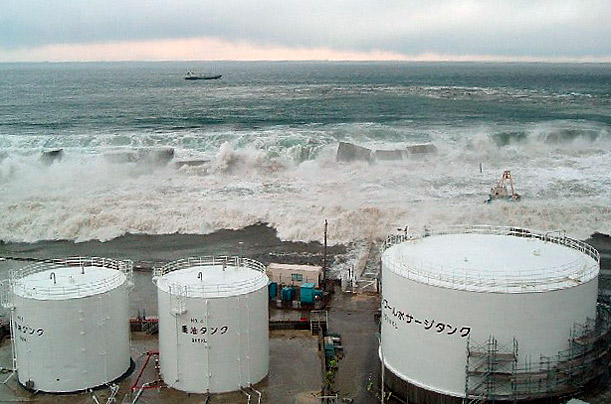
The dark water surged up the 25-30 ft. high shoreline and flooded all six units. Units 1 through 4 were swamped with seawater to a depth of about 15 feet.
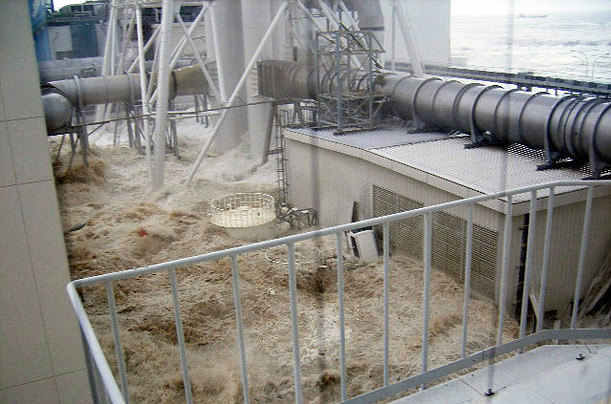
All of the emergency diesels and DC batteries were located in the basements of the three units. In fact, the emergency power systems for units #1 through #4 were actually located below sea level!
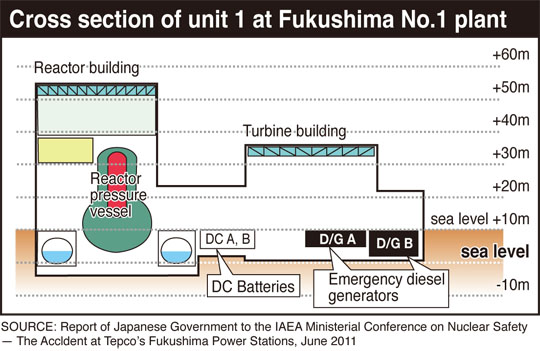
As a result, all four of the unit’s emergency power systems were flooded and rendered inoperable. None of the rooms housing the emergency power sources were water-proofed. The four units were in an accident condition known as “full station blackout”. The government regulatory agencies and Tepco had co-determined that a complete loss of all AC power for long periods of time was too remote a possibility to be considered. One of the back-up emergency diesels for tandem units #5 and #6 remained functional, so all of their emergency systems remained operational throughout the days of crisis with the other four.
Station manager Masao Yoshida soon realized the dire need for some source of electricity, so he sent all available people to scavenge all the emergency lighting and batteries they could find from contractor offices and automobiles in the parking lot. While some emergency lighting was working off self-contained batteries in the control room, work to repower needed instruments had to occur behind the control panels in near-total darkness cut by hand-held flashlight.
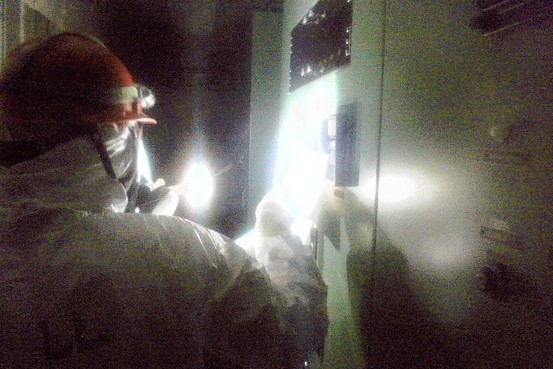
(Tepco archives)
At about 4:45 pm, an hour and a half after the tsunami, some control room instruments for unit #1 were re-energized. Indications were that the steam-powered High Pressure Coolant Injection system was feeding water into the reactor.
Manager Yoshida also called Tepco’s home office in Tokyo for more emergency equipment, including mobile hi-voltage emergency diesels. There was one LAN line functioning, allowing for communication with the outside world. When Yoshida finally got through to Tepco/Tokyo, he found the situation there was chaotic and being exacerbated by demands from the Prime Minister, Naoto Kan. In the chaos, Tepco/Tokyo misunderstood Yoshida and thought they needed to get emergency equipment to both F. Daiichi and F. Daini. Most of the equipment, including desperately-needed batteries, went to Fukushima Daini and an assembly area 20 kilometers inland.
Despite the misunderstood communication, portable contractor generators had restored lighting to the units #1 and #2 control rooms and some instrumentation at about 8:45pm. 15 minutes later, the tandem control rooms for units #3 and #4 were re-lit and some instruments restored.
Local pressure indication for inside the unit #1 reactor was among the instruments recovered and showed about 1,000 psi, which is roughly the same as what would be the case during normal operation. At this point, Manager Yoshida decided to request that Fukushima Prefecture hold a precautionary public evacuation out to two kilometers in case the system would have to be depressurized. Depressurization would release radioactive gasses to the outer atmosphere. At the time, the wind was blowing out to sea, and forecasts indicated it would remain a sea breeze for at least two days. But, Yoshida decided to take the cautious path in case the wind unexpectedly shifted inland. At 8:50pm, Fukushima Prefecture initiated the evacuation.
At 9:23 pm, Prime Minister Naoto Kan ordered the evacuation expanded to three kilometers. Why he did this is unknown. It must be noted that under Japanese law, the Prime Minister assumes essentially dictatorial powers during a national calamity, which was certainly the case after the massive earthquake and tsunami. This is probably why Kan’s arbitrary expansion of the evacuation was not questioned by Yoshida or Fukushima Prefecture.
At about 11pm, radiation levels inside the unit #1 reactor building began increasing. It is possible that water level inside the reactor was creeping below the top of the fuel core and losing the shielding provided by the water. While the core is covered with water, the liquid provides a significant radiation shield between the core and the outer walls of the reactor. As soon as the level drops below the top of the fuel core, the radiation shield is lost, some fuel is exposed, and radiation levels increase considerably in the surrounding reactor building. By 11:50pm, radiation levels inside the reactor building were very high and pressure inside the inner containment building had risen to about 85 psi. This indicated that the safety pressure relief valves had automatically opened and raw radioactive steam was being piped to the 600,000 gallon suppression pool.
Soon after midnight, Manager Yoshida realized the HPCI pumping system and cooling by the Isolation Condenser were no longer doing their job. He had to lower pressure both inside the reactor and the inner containment building so that low pressure fire pumps could be used. At 12:30am, Fukushima Prefecture reported the evacuation was complete and depressurization could begin. However, manager Yoshida had to wait for permission from Tepco/Tokyo, and Tepco was awaiting permission from PM Kan. At 1:30am, Kan extended permission, but with two caveats. First, Yoshida had to wait until a 3pm press conference was held in Tokyo announcing the depressurization. Second, the 3 kilometer radius had to be totally evacuated, which everyone assumed was already done.
It wasn’t.
A mobile emergency hi-voltage diesel arrived soon after the Prime Minister’s orders were received. The driver informed Yoshida that there were still people inside the 3km radius around the nuke station, looking for missing friends and relatives, and picking through the rubble caused by the quake and tsunami. Yoshida asked Fukushima Prefecture to confirm the evacuation, which they did at 1:45am. The Tokyo Press conference was held at 3:06am. However, additional emergency support personnel had arrived at Fukushima Daiichi and reported that the 3km radius was still not evacuated. Frustrated, Yoshida sent some of his personal staff out the see how the evacuation stood. They reported back that the host town of Okuma was not empty and survivors of the tsunami continued searching for lost friends and family along the devastated shoreline.
The full evacuation of Okuma was not complete until about 9am. It took more than an hour to manually operate all the valves needed to depressurize. The long time period was due to two things. The valves were inside the reactor building which was still blacked out. The work had to be done by flashlight. In addition, the radiation levels were so high inside the structure that personnel could only spend a few minutes inside the building before reaching exposure limits. Thus, one team after another was sent in to get the job done. At 10:17 am, the depressurization began.
But, it was too little and too late. Before the 3am Tokyo Press conference happened, the core inside unit #1 had become sufficiently uncovered to cause severe fuel damage and the generation of hydrogen. Over the hours between midnight and depressurization, leaks from the system had created a build-up of gasses in the outer reactor building. The lightest of the gasses, hydrogen, had migrated to the top floor of the building and concentrated.
Ironically, the mobile hi-voltage diesel had been spliced into a switchboard for unit #2 during the morning and early afternoon. It was started at about 3:30pm on March 12th, feeding much needed electricity into the plant. Units one and two are tandem with many shared electrical systems. It should have been only a matter of time before both unit’s emergency cooling systems would have been re-activated.
However, at 3:36pm, the hydrogen concentration in the upper floor of the unit #1 reactor building was so high that it exploded.
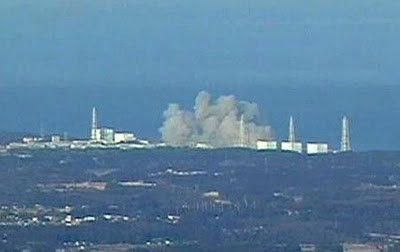
The entire top floor of the unreinforced concrete structure was blown apart. Flying debris struck the mobile diesel and the cabling used to splice into the unit #2 switchboard. Bothe the diesel and cabling were too damaged to use. A second mobile diesel had been slowly working its way from units 5 and 6, through the muck and mire left behind by the tsunami. It was planned to be spliced into tandem units 3 and 4. However, the thick, heavy debris from the unit #1 explosion further blocked the path of the second diesel, bringing it to a halt. Unknown to anyone at the time, the hydrogen explosion of unit #1 would doom the other three units.
Units 2 and 3 were newer than unit #1 and had a few more steam-powered emergency cooling systems available. Unit #2 did not have indication of a need to depressurize until about 5:30pm on March 12th. Plans on how to do it, if actually needed, began to be put together at that point. There were no emergency procedures for the unit, so the staff had to create some. It wasn’t until 10:15am on March 13th that instruments showed the need to depressurize. Depressurization began at about 11:20am concurrent with a Press release issued in Tokyo. This time, there were no delays ordered from the Prime Minister.
Over at Unit #3, the staff had lost all steam-powered cooling systems at about 2:42am on March 13th. At 5am, manager Yoshida ordered unit#3 to prepare for depressurization. A press release was issued in Tokyo at 5:50 am, and the work needed to manually depressurize began. The process was tedious and took a considerable amount of time because of high radiation levels and the need to stop the work due to numerous earthquake aftershocks. At 6:20 am, instruments showed that reactor water level had reached the top of the unit #3 fuel core. At 9am, the safety pressure relief valves opened and pressure rapidly dropped inside the reactor as stem dumped into the 600,000 gallon suppression chamber. Subsequently, pressure in the containment structure began to increase. The inner containment had to be depressurized. This was decided at about 9:35 am.
Seawater cooling for unit #3 began at about 1:15 pm, after all available freshwater was exhausted. Firetrucks were being used to inject the seawater, but the operation of the truck pumps was intermittent. The seawater sources were equipment pits and trenches on the sea-side of unit #3. When one was drained, it took considerable time to run the suction hoses to the next pit/trench. Through the rest of the day and night it seemed that the worst had been averted. However, at 11:01 am on March 14th, a hydrogen explosion with unit #3 happened.
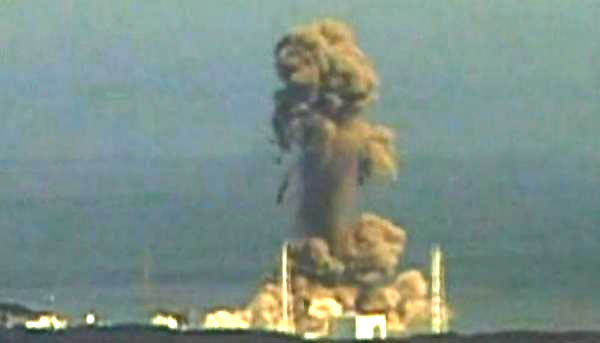
Flying debris damaged the fire engines feeding cooling water into the unit #2 reactor, and the impact of the blast had closed several valves in the depressurization line-up inside the unit #2 containment structure. Once the flow of water restarted, they soon ran out of fresh water to supply the fire pumps feeding the core. Seawater had to be used, and it took several hours to string enough hoses together to get the fire pumps connected to a salt water source. It was 4:30pm on March 14th when the unit #2 control room instruments indicated that its fuel core was uncovering. A fire engine pumped some water into the system for several minutes, bringing the water level above the core. At 5:17pm, the core again began to uncover. By 6:30pm, the core was probably completely uncovered. At 8pm, another firetruck pump was sending water in, but very slowly because it was working against a pressure it was not designed for. At about 9pm, the depressurization flow path was finally restored through the diligent efforts of the unit #2 operators.
An irregular cycling of both depressurization and pumping seawater into the uncovered core continued through the night and early morning of March 15th. There was no indication that the core had been re-covered with water throughout those tense hours. Suddenly, at about 6am on March 15th, a “large impulsive sound” was heard and it seemed to have come from inside the unit #2 containment.
Actually, the sound was later judged to have been a sonic echo from a hydrogen explosion which destroyed the upper two stories of unit #4. Unit #4 had been shut down for several months, so there was no fuel in the reactor. It was discovered during post-accident investigations that the shared air conditioning system with unit #3 had an open conduit which allowed hydrogen from unit #3 to flow into unit #4. The hydrogen migrated out of the 4th floor air conditioning room and migrated up to the 5th floor refueling deck where it concentrated. It is believed that a spark in the 4th floor air conditioning circuitry initiated the explosion, blowing apart the walls of the top two floors of the reactor building.
But, this was not known to the staff in unit #2, nor anyone else in the station’s emergency management team. When reports came into the unit #4 control room of the explosion, the supervisor didn’t believe it. He sent an operator out to check on the condition of the building…not once but twice. Confirmation of the unit #4 explosion was officially confirmed at 8:11 am.
Believing everything that could be done with units 1 through 4 had already happened, and units 5&6 being in a safe condition, Yoshida ordered all un-necessary personnel to “retire” to low-exposure locations to get much needed rest. About 70 operators were to remain on the job to maintain the status quo. Yoshida’s order was misunderstood and more than 90% of the people at F. Daiichi went to Fukushima Daini to await further orders. Regardless, the alternating cycle of depressurizations and seawater cooling injections for all three damaged cores remained in place for nearly two more days. The in-flows of water to the three damaged systems became less intermittent as additional fire trucks arrived at the site.
A kilometer-long emergency cable had been spliced together over a period of days to try and connect the blacked-out station to an energized inland transmission line. It was completed on March 17th. The steady supply of power allowed the operation of installed emergency cooling systems for all three damaged fuel cores, and the ability to use fresh water from various tanks and the condensers in each unit, instead of seawater. The re-powering of the station essentially marked the technical end of the Fukushima Daiichi nuclear accident.
(Greater detail on the accident itself can be found in my E-book “Fukushima: the First Five Days”, available on this website. For events and actions subsequent to March 17th, 2011, see the Fukushima Accident Updates archives for 2011.)
The Damage
The fuel cores for units #1, 2 and 3 were severely damaged. All three suffered meltdowns, with unit #1 having a full, core-relocating excursion. Muon tomography images released in March, 2015, revealed that the entire contents of the core is gone: fuel bundles, cladding, structural materials, and bottom support plate for the fuel. Some Tepco engineers speculate the mixture of the materials (called “corium) may have melted its way through the bottom head of the reactor pressure vessel (RPV) and accumulated on the many-feet-thick, steel-reinforced concrete base mat below. Others (including this writer) doubt the melt-through speculations for two reasons. First, the radioactive isotopic concentrations in the water at the bottom of the containment structure is lower than that found outside the containment vessel. If the corium had melted through the RPV, the contamination levels inside containment should be higher than outside. Second, radiation detectors that have been slid inside the containment show that radiation levels increase as we get higher in elevation above the water beneath the RPV. If there were a melt-through, it should be the opposite. Because radiation levels increase significantly with height above the water surface, it is likely the corium pooled in the bottom head of the RPV, but did not melt-through. It should be noted that the Muon detection image did not show the bottom head.
Units #2 and #3 cores surely suffered severe melting, with unit #3 having the most likely chance of significant core relocation. Worst-case speculations for unit #3 are that some corium may have penetrated the bottom head of the RPV, but not to the degree of the worst-case speculations for unit #1. Unit #2 probably had the least amount of melting, and melt-through of the RPV bottom head is generally considered unlikely. Muon tomography is planned for both units, but has not yet happened as of this writing.
There was a question early-on as to why unit #2 did not have the catastrophic hydrogen explosion experienced with units #1-#3. It turns out that a “blow-out panel”, several square meters in area, was open in the north wall of unit #2’s fifth floor throughout the first week of the crisis. How it was opened, or who may have done it, is unknown. Regardless, it is felt that even with the least core damage of the three units, there might have been enough hydrogen generated for an explosion. It is assumed that the open blow out panel kept enough fresh air circulating through the fifth floor to keep hydrogen concentration below the detonation point.
Another issue raised during the first seven days at Fukushima Daiichi concerned the condition of the used fuel bundles stored in the Spent Fuel Pools (SFP) for units #1 through #4. It was feared that unit #4 SFP was boiling and in danger of going dry. This was due to the appearance of vapor coming from the pool and infrared images taken from satellites. Helicopters were used to drop water on the pool area, and the pilots said they saw no indication of boiling. As it turns out, the pool did get hot enough to produce a stem-like haze through evaporation, similar to the phenomena seen at hot springs around the world. It never boiled. Regardless, the fear of used fuel being uncooled, causing a worse release of contamination, was extended to the other three pools, as well. The reality was the same for all of them; the waters got hot, but none boiled.
Public Impact
A mandatory evacuation was ordered by Tokyo over the ensuing months. The areas evacuated were determined by assumptions on meteorological dispersal of contamination and radiation level estimates taken from detectors hung below helicopters. The order was applied to a 20 kilometer radius around F. Daiichi and a connected “corridor” about 20 kilometers wide that extended to roughly 40 kilometers northwest of the nuke station. The corridor was designated “deliberate evacuation area”. The entire evacuated area was entitled the “exclusion zone”, and popularly dubbed the “no-go zone”.
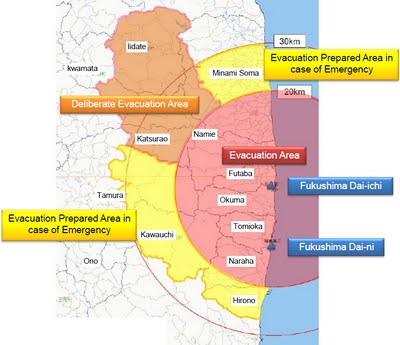
The Tokyo-mandate forced some 75,000 people from their homes. Another ~85,000 voluntarily evacuated from outside the mandated exclusion area, fearing both radiation exposure and anxiety caused by belief that the accident could get worse.
Foods from Fukushima farms were banned from the Japanese marketplace until a monitoring program could be put in place to insure safety. Some species of seafood were found to exceed Japan’s highly-restrictive limits for marketing, and were banned. Milk and dairy products from Fukushima were confiscated to prevent possible ingestion of radioactive Iodine. In the months and years that followed, Fukushima produce and seafood were given detailed monitoring, and none exceeding the national standards ever made it to the consumers. As time passed, nearly all foods were found to be less radioactive than national standards and were available for marketing. The only exception has been a few species of food-fish. However, fear of the possibility of radiation, combined with distrust of the government, caused an on-going boycott of all foods associated with Fukushima Prefecture. Four years after the accident, nearly 20% of the consumer demographic continued to shun all foods from Fukushima, even though contamination was undetectable.
All nuclear plants were ordered to shut down at their first refueling outage following the accident. A moratorium would remain in place until new, stricter safety standards could be created and implemented. The main government regulator at the time of the accident, the Nuclear and Industrial Safety Commission, was replaced by a pseudo-independent Nuclear Regulation Authority in September of 2012. The last nuke to go off-line was in May of 2012, effectively stripping Japan of nearly 30% of its electric generation. The nukes were replaced with restarts of old, moth-balled coal, gas, and oil fueled plants. The increase in fossil fuel imports caused an on-going trade deficit totaling tens of billions of dollars per year. This was reported to be the first trade deficit in Japan since the 1950s. The added costs were passed on to all customers, both residential and business. Many businesses could not remain profitable and moved overseas. New, more severe safety regulations for nukes were finally completed in July of 2013. The first restarts of nukes meeting the new standards are not expected until late summer of 2015.
Finally, there have been no deaths or incidents of medical harm to any member of the public due to radiation exposure. Thorough medical examinations have been given to the mandated evacuees, and many concerned residents from outside the no-go zone, free of charge. Nearly a third of a million children who were age 18 or less at the time of the accident have been screened for thyroid issues; specifically cysts more than 0.5mm in diameter and/or nodules more than 5mm in diameter. In early 2015, roughly 125 children had been discovered with these (pre-cancerous) anomalies, and about 70 have had surgery to remove them. Because no such testing had ever been done before on Japan’s children, Fukushima University medical team extended the screenings to three prefectures hundreds of kilometers from Fukushima Prefecture. It was found that the rate of these anomalies in Fukushima children was actually a bit less than with each of the three prefectures unaffected by the nuke accident. It appears that Tokyo’s immediate banning of all Fukushima dairy products has prevented a recurrence of the child thyroid cancer situation following the 1986 Chernobyl accident.
Next - Time for the truth to be known https://www.hiroshimasyndrome.com/time-for-the-scientific-environmental-and-economic-truth-about-nuclear-power.html

